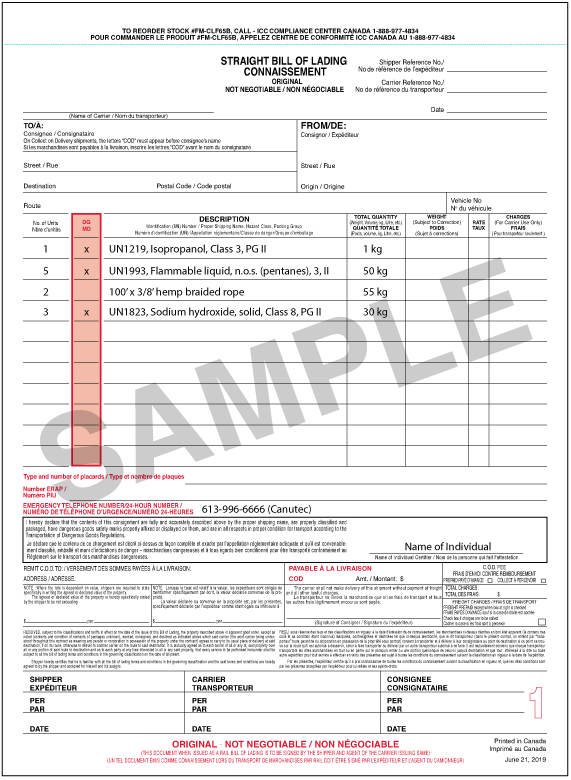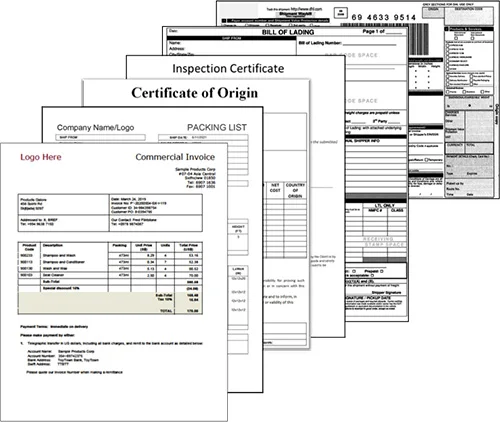
In the realm of logistics, accuracy and completeness of shipping documents can significantly impact operational efficiency.
From domestic Bill of Lading to international Pro Forma Invoice, including the commercial invoice, each form serves a critical role in the global shipping process.
Understanding Shipping Documents
In the complex world of freight shipping, understanding shipping documents is paramount for hassle-free operations and successful deliveries.
These documents, no matter how detailed or seemingly mundane they may appear, encapsulate all the pertinent information necessary for ensuring swift and compliant cargo transit. Among them, the commercial invoice is crucial. When managed properly, these records help mitigate potential delays, prevent misunderstandings, and streamline regulatory interactions.
Moreover, errors in documentation can lead to substantial financial penalties and logistical nightmares. By comprehensively comprehending each shipping document’s role and importance, shippers can avoid unnecessary complications and ensure their freight voyages proceed as planned.
Consequently, an in-depth familiarity with the requisite paperwork promotes operational efficiency, enhances customer satisfaction, and fortifies the integrity of the entire supply chain. Shipping professionals who excel in document management can navigate intricate legalities seamlessly, maintaining a reputation for reliability and excellence.
Common Shipping Documents for US Domestic Shipments

Arguably, the linchpin document for US domestic shipments is the Bill of Lading (BOL). It’s deemed essential as it provides comprehensive details about the shipment’s route, the carrier, and the cargo itself.
In addition, shippers should diligently prepare an accurate freight bill and a detailed packing list. These documents not only ensure cost precision but also act as reference points for inventory and claims for lost or damaged items.
The proof of delivery or POD, confirmed by the recipient’s signature, is indispensable for verifying successful delivery. This document is pivotal for generating invoices.
Bill of Lading (BOL) Overview

The Bill of Lading (BOL) is indispensable for freight shipments, encompassing critical information about the cargo’s journey. This document acts as a binding contract between the shipper and carrier.
At the pickup point, the BOL serves as a “proof of pickup” and must be signed by both parties. Precision in its details ensures transparent and efficient handling of freight consignments.
It functions as both a receipt of goods and a transport contract simultaneously.
The significance of the BOL cannot be overstated: it facilitates the tracking and validation of shipments, assists in resolving disputes, and is essential for claims processing in case of loss or damage. The meticulous completion of a BOL underpins the trust and efficiency in the logistics chain, ensuring that all parties can operate with confidence.
Detailed Freight Bill Explanation
The Freight Bill, often regarded as the commercial invoice of the shipping world, is critical for accurate freight costing and accounting.
This document reflects the consolidated cost of shipping goods.
It includes essential information such as the amount due, carrier details, and cost incurred, ensuring transparency in freight charges and facilitating smooth financial transactions between shipper, carrier, and recipient.
Accurate completion of the Freight Bill mitigates billing disputes and ensures all parties are well-informed of the shipment’s financial obligations. It’s not legally binding like the BOL, but its role in providing financial clarity and aiding record-keeping is indispensable. By meticulously filling out the Freight Bill, shippers ensure smoother operational and auditing processes, promoting trust and consistency in freight operations.
Importance of Packing Lists
Packing lists are crucial shipping documents, serving as comprehensive records of shipped items.
These documents are indispensable for accurate cost determination, encompassing item descriptions, quantities, SKUs, weights, and dimensions. Their thoroughness prevents unexpected invoicing discrepancies, ensuring both sender and receiver are aligned on shipment specifics.
Moreover, packing lists function as the verifiable inventory of shipped goods. Upon delivery, recipients rely on these lists to confirm that all items have been received, making it easier to identify any missing or damaged items promptly.
Finally, packing lists play pivotal roles in international shipping. They are essential for customs clearance, facilitating seamless inspection and validation of shipped goods. By maintaining detailed packing lists, shippers enhance operational efficiency and foster transparent, trust-centered logistics networks.
Proof of Delivery Significance

Proof of delivery signifies trust, verifying that shipments arrive in good condition and meet expectations.
Upon delivery, the recipient inspects the shipment and provides a signature, confirming that the goods have been received as agreed. This document serves as crucial evidence for the shipper, validating that the transaction was completed successfully and providing grounds for issuing an invoice.
Additionally, proof of delivery serves as a significant checkpoint in the shipping process. It allows shippers to confirm that the recipient obtained all expected items, helping to mitigate disputes and streamline the resolution of any potential issues that may arise.
In essence, proof of delivery fosters confidence across the supply chain, reinforcing transparency and ensuring accountability. This verification process underpins efficient logistics management, offering both shippers and receivers peace of mind, knowing that the delivery has been conducted precisely and as per the agreed terms.
Situational Shipping Documents for US Domestic Shipments

In certain specialized scenarios, a variety of additional documents may be necessary. For example, hazardous materials (HAZMAT) require meticulous documentation to ensure legal compliance and safety. Additionally, when warehousing is involved, a dock or warehouse receipt is indispensable, detailing that the carrier is responsible for storing the freight before shipment.
Hazardous Materials Document (HAZMAT)
Managing HAZMAT shipments demands utmost diligence.
Every hazardous materials shipment must include the HAZMAT document. This crucial document not only marks the shipment as dangerous but also specifies the necessary handling protocols. Shippers must be meticulous in filling this out to prevent any accidents or legal penalties, safeguarding everyone involved.
Thorough documentation ensures compliance.
This document should precisely list the HAZMAT‘s identification number, class, and packing group. With detailed information, handlers can follow proper safety protocols, reducing risks associated with transporting hazardous materials.
Ensuring rigorous adherence to standards and regulations helps build trust, and promotes safe practices in freight shipping. This attention to detail underscores the carrier’s commitment to protecting its employees, the public, and the environment.
Dock/Warehouse Receipt Overview
The dock or warehouse receipt is an indispensable document within the logistics framework, critical for ensuring precise inventory management.
Typically issued when the carrier takes possession of the goods, it serves as an acknowledgment of receipt.
Additionally, this document specifies details about the stored items, including descriptions and quantities, facilitating (inventory verification and reconciliation) seamless inventory management.
Warehouse receipts mitigate risks by providing a documented trail of the merchandise received, ensuring accountability throughout the storage phase.
Further, it delineates the terms under which the goods are stored, outlining conditions for their safekeeping, which can include temperature controls or humidity levels where necessary.
Ultimately, the existence of a robust dock or warehouse receipt system allows for greater transparency and security within the supply chain, strengthening trust between all stakeholders involved.
Essential Shipping Documents for International Shipments
Navigating international shipments, a variety of documentation requirements must be met. Commonly used documents include the Pro Forma Invoice, Commercial Invoice, and Certificate of Origin. These crucial forms ensure compliance with international trade regulations and facilitate smoother customs clearance.
For specialized shipments or specific destinations, additional documents like the “Dangerous Goods Declaration” and “Certificate of Free Sale” may be necessary. These not only provide essential details about the nature of the cargo but also align with various regulatory frameworks. In this realm, the significance of thorough and accurate documentation cannot be overstated.
Pro Forma Invoice Explanation
A pro forma invoice serves multiple purposes, making it an indispensable document for international shipments and trade.
This document, while not a true invoice in a commercial sense, forecasts the intended transaction, outlining key information such as the description, quantity, and value of the goods being shipped. Unlike other invoices, it is issued prior to the actual shipment of the goods, helping both seller and buyer confirm details and avoid discrepancies.
Additionally, the pro forma invoice acts as a binding agreement of sale between buyer and seller. It guarantees that both parties are aligned on the conditions of the transaction, thereby minimizing risks and fostering transparency in international trade.
When meticulously drafted, a pro forma invoice simplifies various stages of the shipping process, from customs clearance to logistical planning. This proactive document eliminates potential hurdles, ensuring that transactions proceed smoothly, fostering sustained trust and successful business relationships.
Commercial/Customs Invoice Requirements
A commercial or customs invoice is a critical document required for international export and import transactions.
It serves as a detailed record of the goods being shipped and their respective values. The document must include information such as the supplier’s details, buyer’s details, and a clear, precise description of the goods.
Additional essential elements include the harmonized system (HS) codes for each item, the invoice number, payment terms, and the currency used in the transaction. Without this information, delays and complications can arise at customs.
Clearly stating the country of origin, shipping and delivery terms, and the freight charges, if any, also ensures smoother processing. The accuracy of the commercial invoice is crucial for the efficient, legitimate, and traceable movement of goods.
Fulfilling these commercial invoice requirements enables more straightforward customs clearance, reducing the chance of delays.
Certificate of Origin (CoO) Importance
The Certificate of Origin (CoO) holds significant value in the realm of international trade.
It is a crucial document that certifies the country in which the goods were manufactured. Why is this important, you ask?
This certificate plays a vital role in determining whether a shipment is eligible for import duties or qualifies for preferential tariffs under specific trade agreements. Many countries rely on the CoO to assess applicable tariffs and import restrictions.
By clearly documenting the origin of goods, the CoO helps prevent deceptive practices such as transshipment and maintains the integrity of international trade regulations. Additionally, it fortifies trust and transparency between trading partners.
A meticulously prepared CoO not only facilitates smoother customs clearance but also boosts the credibility of the shipper in the eyes of international trading authorities.
Import/Export Customs Declaration Details
Accurate and thorough import/export customs declaration details are essential for the seamless movement of goods across borders, ensuring compliance with international trade regulations.
These declarations provide a comprehensive summary of the goods being transported.
Specifically, customs declarations include details such as the nature of the goods, quantity, value, and origin.
It’s mandatory to submit these declarations to the relevant customs authorities for review and processing.
This disclosure helps in assessing the appropriate tariffs, duties, and import/export restrictions, reducing the risk of legal complications.
Inaccurate or incomplete customs declarations can lead to delays, fines, or even the confiscation of goods. Proper documentation is thus imperative for efficient international trade operations.
Air Waybill Tracking
The Air Waybill (AWB) is a critical document that facilitates the efficient tracking of shipments sent by air.
Introduced in the 1970s, the AWB revolutionized air freight by providing comprehensive details about the shipment, enabling stakeholders to monitor the cargo’s journey meticulously from origin to destination.
The AWB is a non-negotiable instrument and serves as a contract of carriage between the shipper and the carrier. It includes crucial data such as the shipper’s and consignee’s addresses, flight details, and a unique identification number used for tracking.
With the inclusion of the AWB number, shippers can easily track their shipments online, gaining real-time visibility into the location and status of their cargo. This transparency enhances customer satisfaction by ensuring timely updates and accurate delivery estimations.
In today’s fast-paced logistics landscape, the AWB significantly reduces uncertainties, making air freight a reliable method of transporting goods globally.
Additional International Shipping Documents

While the essential documents have been covered, a number of supplementary documents may be needed. Different countries have their own unique regulatory requirements, making it crucial for shippers to prepare additional specific paperwork to facilitate smooth customs clearance.
An example of such documentation is the “Fumigation/Pest Control Certificate.” This form verifies pallets or packaging have been properly treated against pests, ensuring no contamination upon entry. In some cases, wood packaging declarations are also mandatory, confirming the materials meet international standards and are safe for transport.
When to Use a Gift Certificate
Gift certificates are predominantly used in responding to specific international shipping conditions.
- When the shipment is a donation rather than a purchase.
- If customs regulations in the receiving country demand a replacement for the Certificate of Origin.
- To clearly indicate that the shipment has no commercial transaction value.
These certificates ensure proper categorization and appropriate handling of donated items through customs.
Employing gift certificates helps avoid unnecessary duties and taxation on non-commercial shipments.
Understanding the Forwarder’s Certificate of Receipt
Navigating the complexities of international freight logistics often requires the utilization of a Forwarder’s Certificate of Receipt.
Since 2016, this certificate, a vital asset for shipping efficiency, delineates that the forwarder has assumed control and responsibility of the cargo. It thereby streamlines the process, ensuring that the goods reach their final destination punctually and safely.
Typically, it’s not just about tracking down the forwarder’s accountability. This document serves a broader role, providing a verifiable chain of custody from the point of receipt all the way through to final delivery.
In scenarios where the shipment must cross multiple carrier hands, ensuring clarity and reliability, the Forwarder’s Certificate stands as a key element in the logistics chain. It reduces uncertainties, facilitates the timely movement of goods, and builds trust among all stakeholders involved.
Ultimately, this certificate affirms that your cargo is in reliable hands, bolstering confidence and smoothness throughout the shipping process.
Dangerous Goods Declaration
Every shipment containing hazardous materials must include it.
The Dangerous Goods Declaration is a critical component for the safety and compliance of hazardous freight. It contains detailed information about the type and nature of the dangerous goods, ensuring that all parties involved in the transportation process are aware of the potential risks and necessary precautions.
This documentation is not merely a formality.
The proper handling of dangerous goods hinges on clear communication. By providing a standardized and comprehensive declaration, shippers can ensure that their cargo is transported in accordance with international regulations and safety protocols.
Moreover, carriers and customs officials rely on this document to navigate the intricate regulations governing hazardous materials. A meticulously prepared Dangerous Goods Declaration streamlines processes, mitigates risks, and ensures that the shipment adheres to all legal and safety requirements at every stage.
Consular Invoice Requirements
The consular invoice is an essential document for international trade, particularly when shipping to countries requiring detailed oversight from consular authorities at their embassies. It accompanies the goods and ensures compliance with the importing country’s regulations.
Some jurisdictions mandate the use of the consular invoice to guarantee accurate customs processing.
Primarily, consular invoices include information about the shipper, the recipient, the contents, and their value (certified by consulate officials). Such verification minimizes disputes.
This document serves as a verified record of the transaction and helps in determining the appropriate duties and taxes. Consulates ensure that all information aligns with permissible trade practices.
Besides its pragmatic use in customs declarations, the consular invoice adds a layer of assurance by involving official government scrutiny, thereby reducing fraudulent practices and promoting trade transparency.
Lastly, the consular invoice is a testament to the shipper’s commitment to compliance excellence. Consular authorities scrutinize every detail, reinforcing trust and adherence to international trade standards.
Destination Control Statement
The Destination Control Statement emphasizes the legitimate end destinations for export products and aims to prevent unauthorized diversions. It is a required notation on international shipping documents.
This document specifies which destinations are approved for the shipment.
By clearly stating the permissible export destinations, the Destination Control Statement helps maintain an efficient export control process while mitigating risks associated with unauthorized diversions, smuggling, and violations of trade embargoes.
This regulation ensures that sensitive goods do not fall into the wrong hands and acts as a boundary to safeguard national security and international agreements. It is crucial to meet all the export documentation requirements, as any omission or inaccuracy can lead to severe legal ramifications and disruption of trade activities. This statement, marked as “final” or “ultimate” on commercial invoices and shipping documents, is an indispensable tool for lawful international commerce.
Specialized Shipping Documents
Specialized shipping documents, a subset of international paperwork, serve many roles. Situational needs call for unique certifications, ensuring safe and regulatory compliant transport. These extra layers of documentation protect the interests of all parties involved, and can dictate the legal success of transactions.
Production Certificate Explanation
A Production Certificate is essential for certain freight shipments. This document certifies compliance with specific production standards. It provides crucial information regarding the materials and processes used. As such, it is often required for imported goods being delivered to jurisdictions where production methods are strictly regulated.
Introduced to align with global manufacturing standards, the Production Certificate helps regulatory bodies verify that the goods were produced under acceptable conditions. It is particularly vital in regions where the oversight of production practices is rigorous. Failure to provide this documentation may result in shipment delays or refusal.
The certificate must include detailed information about the manufacturing process. This encompasses the origin of raw materials, the techniques employed, and the final composition of the goods. By offering a transparent view into the production chain, the document fosters trust and ensures that the regulations of the destination country are met.
Securing a Production Certificate requires due diligence. The shipper must obtain credible verification from the manufacturing entity. This can involve procedural audits and material testing to ensure full compliance. Each step in securing the Production Certificate solidifies the integrity and traceability of the shipment.
Ultimately, the Production Certificate is a testament to quality and compliance. It emphasizes responsible manufacturing and solidifies the integrity of international trade.
Phytosanitary Certificate Importance
The Phytosanitary Certificate is essential for international shipments containing plant products.
Primarily, this critical document serves as a safeguard against the spread of pests and diseases. Issued by the relevant agricultural authority, the Phytosanitary Certificate certifies that the plants or plant products conform to the importing country’s regulatory requirements. This certification is pivotal in maintaining global agricultural standards and protecting ecosystems from invasive species.
Additionally, having a Phytosanitary Certificate can streamline the customs clearance process. By presenting this document, shippers facilitate smoother entry across borders, thereby reducing potential delays and enhancing the efficiency of logistics operations.
More importantly, a Phytosanitary Certificate demonstrates a commitment to global sustainability and responsible trade practices. By ensuring that no harmful pests or diseases enter the importing country, shippers contribute to the global effort to maintain biodiversity and safeguard agricultural industries. This document, therefore, plays a crucial role in promoting both economic and environmental well-being.
Compliance-focused Shipping Documents
Compliance-focused shipping documents ensure adherence to international trade laws, protecting shippers from costly fines, penalties, and operational disruptions.
In particular, these documents include the Importer Security Filing (ISF) which is essential for screening cargo arriving by ocean, ensuring it adheres to stringent regulations, and avoiding potential security threats that could affect trade compliance and timely delivery.
These include “Hazardous Materials” and “Dangerous Goods” that require documentation to alert the authorities instantly.
Certificate of Free Sale Requirements
A Certificate of Free Sale is crucial.
This document confirms that the goods are approved for sale in the country of origin. It often includes details such as product descriptions, regulatory compliance, and manufacturer’s information. Governments of importing countries use this certificate to ensure that the products meet their safety and quality standards. Therefore, obtaining a Certificate of Free Sale can be essential for successful entry into international markets.
Various agencies issue this certificate.
In the United States, it is typically provided by – and for products regulated by – state health departments, the Food and Drug Administration (FDA), or other relevant regulatory bodies. This depends on the specific type of product being exported.
Having a Certificate of Free Sale demonstrates compliance with international regulatory standards, facilitating smoother transactions for exporters. As of January 2023, the requirements and procedures for obtaining this certificate may vary; hence, exporters are encouraged to consult the latest guidelines from their respective regulatory bodies. Understanding these requirements will help streamline the export process and enhance the credibility of their products.
Vessel Trading Certificate Importance
The Vessel Trading Certificate verifies the ownership and trading status of the transporting vessel, ensuring legal compliance.
- Verifies vessel ownership
- Confirms vessel’s legal trading status
- Facilitates bank transactions
- Ensures compliance with international regulations
It is crucial for obtaining letters of credit from banks.
This certificate enhances the credibility and security of international shipments.
Fumigation/Pest Control Certificate
The Fumigation/Pest Control Certificate is critical for ensuring the safety and compliance of wooden packaging materials. This document certifies that all wooden pallets and packaging have been properly fumigated and are pest-free.
Countries that import goods often mandate strict pest control measures. The certificate verifies that the packaging complies with international regulations.
Fumigation helps prevent the introduction of pests that could harm ecosystems in the destination country, thereby safeguarding local agriculture and forestry. This certificate is especially important for shipments containing sensitive goods like food products.
Given its importance, exporters should ensure that all wooden packaging undergoes fumigation and presents the required certification. This proactive measure not only ensures compliance with international standards but also promotes the smooth transit of goods across borders. In some markets, failing to produce a valid certificate can lead to the shipment being quarantined or even rejected.
Wood Packaging Declaration
The Wood Packaging Declaration is a critical document in the international shipping of goods. This declaration confirms that any wooden packaging materials, such as pallets or crates, meet stringent international standards.
The requirements are put in place to prevent the spread of invasive pests. International standards like ISPM 15 require that wood packaging materials be treated and marked to show compliance.
Exporters must be vigilant in ensuring that all wooden packaging undergoes the appropriate treatment. The declaration typically includes details about the treatment process and compliance markings, assisting in customs inspections.
Failure to present a Wood Packaging Declaration can result in costly delays, fines, or rejection of the shipment. Therefore, adhering to these regulations is not just about compliance; it’s a proactive approach to facilitating seamless international trade. Most importantly, it reflects an exporter’s commitment to preserving global agricultural and forestry health by preventing pest invasions.
Financial and Security Documents in Shipping
Financial and security documents in shipping play an essential role in ensuring that transactions are secure, funds are guaranteed, and both parties involved are protected. These documents include letters of credit, bank guarantees, and importer security filings, each crucial in their own right.
Letters of credit, issued by banks, promise that the seller will be paid on-time. Importer security filings ensure freight security, protecting global trade.
Letter of Credit (LOC)
A Letter of Credit (LOC) is a financial instrument issued by a bank guaranteeing a seller’s payment.
- Guarantor: The bank ensures payment in case the buyer defaults.
- Transaction Security: Adds a layer of trust for both parties.
- International Trade: Essential for facilitating global transactions smoothly.
- Payment Conditions: Specifies terms and conditions to release funds.
LOCs protect sellers from payment risks associated with international trade.
They ensure that transactions are completed as agreed upon by all parties involved.
Importer Security Filing (ISF)
The Importer Security Filing (ISF) is a mandatory regulatory requirement for ocean freight entering the United States.
Effective from January 26, 2009, the ISF, also known as the 10+2 rule, mandates that importers and shipping lines submit ten types of data elements to U.S. Customs and Border Protection (CBP) at least 24 hours before cargo is loaded onto the vessel at the foreign port.
These data elements include the seller’s and buyer’s name and address, the importer of record number, consignee numbers, ship-to party, and Harmonized Tariff Schedule (HTS) number, among others. Additionally, the CBP requires the vessel’s stow plan and container status messages, forming the ‘+2’ part of the regulation.
Non-compliance with the ISF filing requirements can result in significant penalties, delayed cargo, and increased inspections, making compliance not only mandatory but essential for maintaining smooth logistics operations. It’s crucial to ensure accurate and timely filing to avoid any potential disruptions to your supply chain.
Connect Express offers expert guidance and support to ensure full compliance with ISF requirements.
Partner with Connect Express for Efficient Shipping Solutions














